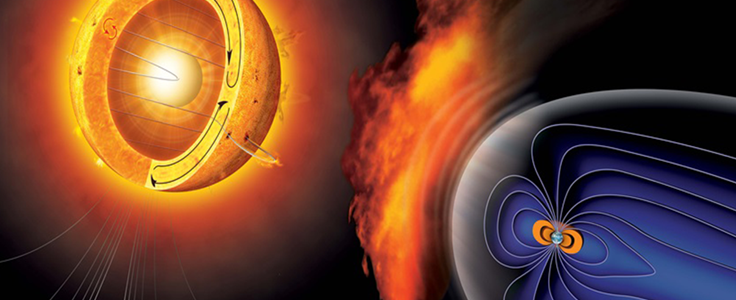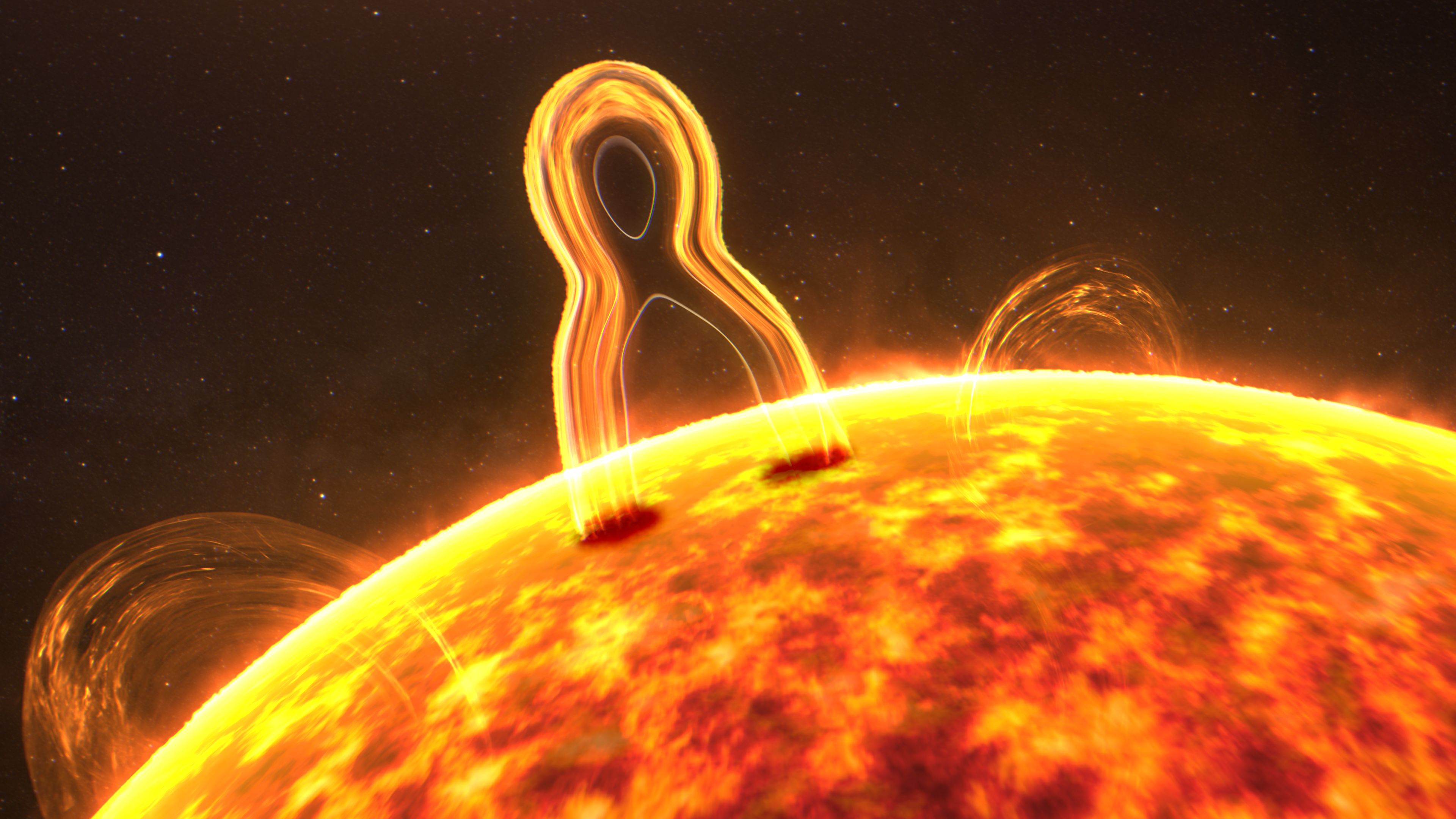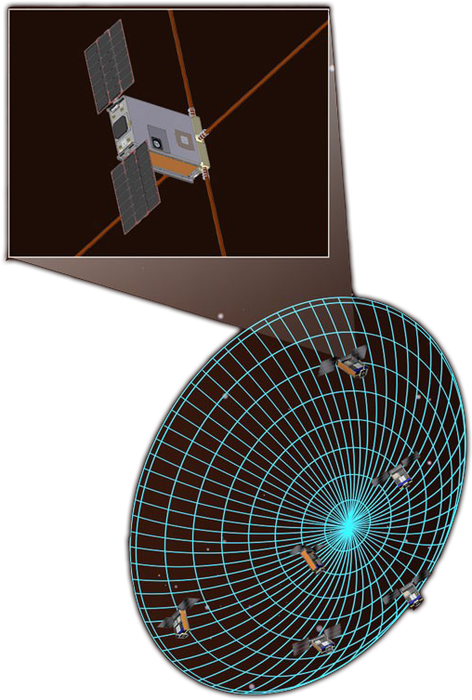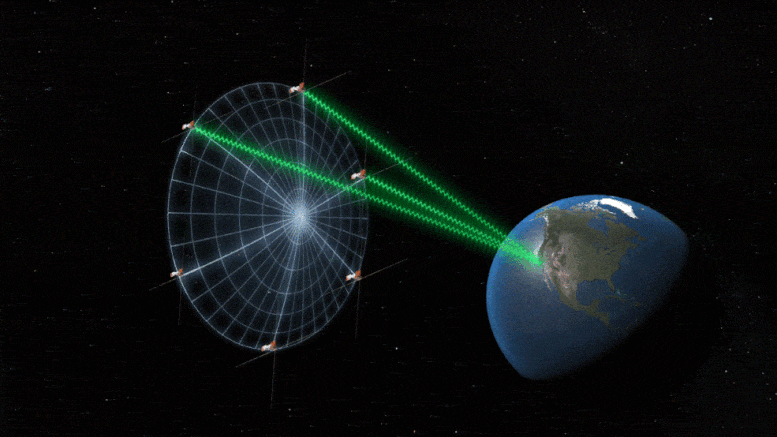
SunRISE
Science Background
Space Weather
Space Weather refers to the environment between the Sun and the Earth.  The study of space weather focuses on the impacts it has on satellites in orbit and technology on Earth. Space weather typically originates from the Sun in the form of solar wind/flares or coronal mass ejections. This energy from the Sun hits the Earth’s magnetosphere, energizing the particles as they accelerate towards Earth’s ionosphere, thermosphere, and upper atmosphere. These interactions can produce strong x-rays that can block high-frequency radio communication, while coronal mass ejections can create geomagnetic storms that induce an excess current that can impact and even shut down power grids. These impacts highlight the importance of understanding space weather to better forecast and prepare for space weather events.
The study of space weather focuses on the impacts it has on satellites in orbit and technology on Earth. Space weather typically originates from the Sun in the form of solar wind/flares or coronal mass ejections. This energy from the Sun hits the Earth’s magnetosphere, energizing the particles as they accelerate towards Earth’s ionosphere, thermosphere, and upper atmosphere. These interactions can produce strong x-rays that can block high-frequency radio communication, while coronal mass ejections can create geomagnetic storms that induce an excess current that can impact and even shut down power grids. These impacts highlight the importance of understanding space weather to better forecast and prepare for space weather events.
Coronal Mass Ejections
A Coronal Mass Ejection (CME) is a solar event characterized by the eruption of  plasma and magnetic fields at the corona of the Sun. CMEs originate from twisted magnetic fields within the Sun that explode after abrupt realignment of those fields. As CMEs travel away from the Sun, they accelerate Solar Energetic Particles (SEPs), such as electrons and protons. Scientists are pursuing a better understanding of the structure of CMEs and how they accelerate SEPs. Understanding CMEs would allow scientists to make better predictions of CME occurrence and design proper CME warning systems.
plasma and magnetic fields at the corona of the Sun. CMEs originate from twisted magnetic fields within the Sun that explode after abrupt realignment of those fields. As CMEs travel away from the Sun, they accelerate Solar Energetic Particles (SEPs), such as electrons and protons. Scientists are pursuing a better understanding of the structure of CMEs and how they accelerate SEPs. Understanding CMEs would allow scientists to make better predictions of CME occurrence and design proper CME warning systems.
The Magnetosphere
The magnetosphere is the region of space around an object in which the object’s magnetic field is dominant.  Both the Earth and the Sun have a magnetosphere. The Sun’s magnetosphere interacts with the Earth’s and they interact, decreasing the amount of radiation that reaches the Earth – the Earth’s magnetosphere protects us from UV rays and other forms of radiation from the Sun, and the Sun’s helps to protect us from galactic cosmic radiation.
Both the Earth and the Sun have a magnetosphere. The Sun’s magnetosphere interacts with the Earth’s and they interact, decreasing the amount of radiation that reaches the Earth – the Earth’s magnetosphere protects us from UV rays and other forms of radiation from the Sun, and the Sun’s helps to protect us from galactic cosmic radiation.
Earth’s Atmosphere
Earth’s atmosphere is composed of nitrogen most abundantly, oxygen secondarily, and a perceptible amount of argon and carbon dioxide to fill the rest. The thermosphere, which extends from 56 miles (90 km) to between 310 and 620 miles (500 and 1,000 km), is where auroras occur when particles get ionized by solar radiation. This ionized layer poses a great challenge to astronomers who use ground telescopes to study the Sun because it rejects any radio signals that are less than 15 MHz, where SEPs fall under. Thus, it is important that we establish space-based telescopes in order to obtain a relatively unobtrusive view of the Sun.
secondarily, and a perceptible amount of argon and carbon dioxide to fill the rest. The thermosphere, which extends from 56 miles (90 km) to between 310 and 620 miles (500 and 1,000 km), is where auroras occur when particles get ionized by solar radiation. This ionized layer poses a great challenge to astronomers who use ground telescopes to study the Sun because it rejects any radio signals that are less than 15 MHz, where SEPs fall under. Thus, it is important that we establish space-based telescopes in order to obtain a relatively unobtrusive view of the Sun.
Solar Bursts
Solar bursts are low-frequency solar radio emissions that arise from the solar atmosphere.  The solar bursts that SunRISE focuses on are either categorized as Type II or Type III. Type II bursts are produced by shock accelerated electrons, while type III bursts are produced by flare accelerated electrons. By understanding the process in which these bursts progress and are developed, space weather can be more accurately predicted.
The solar bursts that SunRISE focuses on are either categorized as Type II or Type III. Type II bursts are produced by shock accelerated electrons, while type III bursts are produced by flare accelerated electrons. By understanding the process in which these bursts progress and are developed, space weather can be more accurately predicted.
Radio Instrumentation
CubeSats
 CubeSats are a type of small satellite that is commonly used in space research because of their ability to be assembled with commercial off-the-shelf electronic and structural components. They also have specific criteria for shape, size, and weight which helps reduce costs for building and deployment and allows them to be mass-produced. The standard unit of a CubeSat is 1U or 10 cm by 10 cm by 10 cm and is 1-1.33 kg. CubeSats are made in multiples of these units which allow for sizes of 1.5U, 2U, 3U, and 6U. The CubeSats deployed in SunRISE are 6U.
CubeSats are a type of small satellite that is commonly used in space research because of their ability to be assembled with commercial off-the-shelf electronic and structural components. They also have specific criteria for shape, size, and weight which helps reduce costs for building and deployment and allows them to be mass-produced. The standard unit of a CubeSat is 1U or 10 cm by 10 cm by 10 cm and is 1-1.33 kg. CubeSats are made in multiples of these units which allow for sizes of 1.5U, 2U, 3U, and 6U. The CubeSats deployed in SunRISE are 6U.
Radio Interferometry
 Radio interferometry allows us to see and capture low-frequency signals. In the past, there was a limit to a range of signals scientists could see, because the longer wavelength of a signal, the larger a telescope is required for observation (many signals of interest are on the lower half of the electromagnetic spectrum). Building a single large telescope is not economical and is also restricted by mechanical constraints. Radio interferometry uses mathematical and physical models to patch incoming signals received by many different telescopes together. It reconstructs images that would have required a telescope that is hundreds, if not thousands, times its size. Now, the diameter of the Earth is used as the size of telescopes, making groundbreaking discoveries every day.
Radio interferometry allows us to see and capture low-frequency signals. In the past, there was a limit to a range of signals scientists could see, because the longer wavelength of a signal, the larger a telescope is required for observation (many signals of interest are on the lower half of the electromagnetic spectrum). Building a single large telescope is not economical and is also restricted by mechanical constraints. Radio interferometry uses mathematical and physical models to patch incoming signals received by many different telescopes together. It reconstructs images that would have required a telescope that is hundreds, if not thousands, times its size. Now, the diameter of the Earth is used as the size of telescopes, making groundbreaking discoveries every day.
References
1. Alibay, Farah et al. “SunRISE Status: Concept Development Update.” IEEE Aerospace Conference Proceedings. Vol. 2018-March. IEEE Computer Society, 2018. 1–11. IEEE Aerospace Conference Proceedings. Web.
2. “Coronal Mass Ejections.” Coronal Mass Ejections | NOAA / NWS Space Weather Prediction Center, www.swpc.noaa.gov/phenomena/coronal-mass-ejections.
3. Ellingson, Steven W, et al. “The Long Wavelength Array.” Proceedings of the IEEE, vol. 97, no. 8, Aug. 2009, pp. 1421–1430.
4. Garner, Rob. “Solar Storm and Space Weather – Frequently Asked Questions.” NASA, NASA, 19 Mar. 2015, www.nasa.gov/mission_pages/sunearth/spaceweather/index.html.
5. Gregersen, Erik. “Heliosphere.” Encyclopædia Britannica, Encyclopædia Britannica, Inc., 10 Sept. 2018, www.britannica.com/science/heliosphere. 6. “Heliosphere.” NASA, NASA, science.nasa.gov/heliophysics/focus-areas/heliosphere.
7. Kasper, Justin C. SunRISE, Sun Radio Interferometer Space Experiment. July 30th, 2018.
8. Kasper, Justin. “The Sun Radio Interferometer Space Experiment (SunRISE): Revealing How Energetic Particles are Accelerated and Released into Interplanetary Space.” 42nd COSPAR Scientific Assembly 2018, Pasadena, California, July 14-22. Presentation.
9. Layers of Earth’s Atmosphere. scied.ucar.edu/atmosphere-layers.
10. “Magnetosphere.” Magnetosphere – an Overview | ScienceDirect Topics, 2015, www.sciencedirect.com/topics/earth-and-planetary-sciences/magnetosphere. “Magnetospheres.” NASA, NASA, science.nasa.gov/heliophysics/focus-areas/magnetosphere-ionosphere.
20. Potter, Sean. “NASA Selects Mission to Study Causes of Giant Solar Particle Storms.” NASA, NASA, 30 Mar. 2020, www.nasa.gov/press-release/nasa-selects-mission-to-study-causes-of-giant-solar-particle-storms.
21. Reeve, Whitham D. “Long Wavelength Array Active Crossed-Dipole Antenna.” LWA Active Crossed-Dipole Antenna, 22 Feb. 2014, www.reeve.com/RadioScience/Antennas/ActiveCrossed-Dipole/LWA_Antenna.htm.
22. Space Weather Impacts. www.swpc.noaa.gov/impacts. “Structural Dynamics Test of Spiral Tube Actuator for Controlled Extension / Retraction (STACER) Antenna Deployment in Microgravity.” NASA, NASA, flightopportunities.nasa.gov/technologies/55/.
24. Thompson, A. R., et al. Interferometry and Synthesis in Radio Astronomy. 3rd ed., Springer Open, 2017.
25. US Department of Commerce, NOAA. Layers of the Atmosphere. 12 Aug. 2019, www.weather.gov/jetstream/layers.
26. Zell, Holly. “The Difference Between Flares and CMEs.” NASA, NASA, 10 Feb. 2015, www.nasa.gov/content/goddard/the-difference-between-flares-and-cmes.
27. Zell, Holly. Earth’s Atmospheric Layers. 2 Mar. 2015, www.nasa.gov/mission_pages/sunearth/science/atmosphere-layers2.html.
28. Zell, Holly. Space Weather. 18 May 2015, www.nasa.gov/mission_pages/rbsp/science/rbsp-spaceweather.html. “Space Weather Phenomena.” Space Weather Phenomena | NOAA / NWS Space Weather Prediction Center, www.swpc.noaa.gov/phenomena.
29. International Civil Aviation Organization. “New Global Aviation Space Weather Network Launched.” ICAO, 20 May 2023, https://www.icao.int/Newsroom/Pages/New-global-aviation-space-weather-network-launched.aspx. Accessed 15 Aug. 2023.
30. NASA. “Solar Dynamics Observatory: Coronal Mass Ejections (CMEs) Graphic.” NASA, https://www.nasa.gov/mission_pages/sunearth/science/cme-graphic.html. Accessed 15 Aug. 2023.
31. Reames, Donald V. “Taking Stock of Cosmic Rays in the Solar System.” Eos, Transactions American Geophysical Union, vol. 103, 2022, https://eos.org/articles/taking-stock-of-cosmic-rays-in-the-solar-system. Accessed 15 Aug. 2023.
32. SciTechDaily. “First of NASA’s SunRISE Satellites Complete, Will Track Hazardous Explosive Space Weather Events.” SciTechDaily, 8 June 2023, https://scitechdaily.com/first-of-nasas-sunrise-satellites-complete-will-track-hazardous-explosive-space-weather-events/. Accessed 15 Aug. 2023.
33. NASA Jet Propulsion Laboratory. “Sun Radio Interferometer Space Experiment (SunRISE).” NASA JPL, https://www.jpl.nasa.gov/missions/sun-radio-interferometer-space-experiment. Accessed 15 Aug. 2023.
